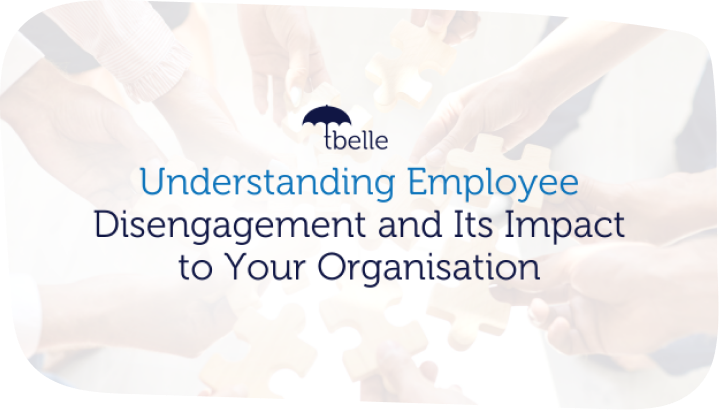Did you know?
There are 24% disengaged employees worldwide!

Table of Contents
According to a Gallup study by Nink and Robison (2016), nearly one-quarter or 24% of the global workforce is disengaged. This means a significant portion of employees are emotionally checked out, unlikely to be invested in their work, and potentially hindering overall productivity and morale.
Employee engagement refers to the emotional commitment and involvement of employees in their work and the organisation as a whole. It’s a critical factor influencing not just the happiness of employees but also the overall productivity and success of a business. An engaged employee is not just working for a paycheck or the next promotion; they care about their work and the organisation deeply, often going above and beyond to contribute to its success.
Businesses must prioritise nurturing a culture of engagement. A better work environment where employees feel connected and valued not only boosts productivity but also cultivates a workplace where innovation thrives and loyalty grows. Let’s find out more about employee disengagement and uncover how it impacts an organisation’s culture, productivity, and employees’ performance.
Understanding Employee Disengagement
Disengaged employees are not simply unhappy; they lack the motivation and enthusiasm to go above and beyond. They may exhibit signs like poor work quality, increased absenteeism, and negativity, ultimately hindering a company’s success.
While unhappiness can certainly contribute to disengagement, it’s a deeper issue. Let’s find out more about employee disengagement and the factors that contribute to this issue.
 Employee disengagement refers to the state where employees feel psychologically unattached to their work and organisation. Gallup, a leading research and consulting company, estimates a staggering 24% of employees worldwide are disengaged. This translates to a significant cost for businesses.
Employee disengagement refers to the state where employees feel psychologically unattached to their work and organisation. Gallup, a leading research and consulting company, estimates a staggering 24% of employees worldwide are disengaged. This translates to a significant cost for businesses.
In a separate report by Gallup entitled The State of the Global Workplace: 2023 Report, they revealed that nearly six in 10 employees psychologically disengage from work and when combined with actively disengaged employees, low engagement costs the global economy $8.8 trillion dollars.
Employee disengagement is a significant issue that can have profound effects on organisational productivity and culture. Understanding its stages can help managers and HR professionals intervene effectively before employees completely check out. Here’s an exploration of each stage, backed by research and studies.
The initial stage of disengagement is often marked by emotional disconnection, where employees begin to show signs of a decline in motivation and commitment to their work and the organisation. This stage is characterised by a growing indifference towards tasks and goals that previously might have excited them.
As disengagement progresses, it becomes evident through various behavioural changes. This stage can manifest as increased absenteeism—employees start taking more sick days than usual or often arrive late and leave early.
Gallup survey results mentioned in Forbes, indicates that disengaged employees have a 37% higher absenteeism rate. Other signs include a lack of initiative, missing deadlines, diminished work quality, and avoiding responsibilities. These behavioural changes not only affect the individual’s performance but also impact team dynamics and overall workplace morale.
The final stage of disengagement is complete withdrawal. This is when employees have mentally checked out of their roles. They might physically be at work but are no longer mentally or emotionally present.
Gallup has termed this situation as “Quiet Quitting” to describe a phase where employees silently disengage from their work. Although they might be physically present at their desk or logged into their computer, their engagement and productivity are minimal. The survey found out that about 6/10 employees fell to this category which is equivalent to 9% of global GDP.
While the emotional detachment of disengaged employees is a clear sign of trouble, it’s just the tip of the iceberg. According to a Gallup study, engagement begins at the local level through managers’ initiatives, manager-to-manager support and organised classes led by human resources.
The same study also reveals that a high percentage of managers around the world are not meeting the needs of their employees. Managers who fail to address the engagement needs of their team can become obstacles to the performance of individual employees, the team, and the entire company.
There are still a lot of factors that cause employee disengagement but the most important thing is, organisations must address this issue promptly. To effectively mitigate disengagement, managers or employers must delve deeper and explore the various factors that push employees down this path in the first place. Some of the reasons include:
- Lack of recognition and appreciation
- Poor work-life balance
- Unclear expectations or goals
- Limited growth and development opportunities
- Unhealthy workplace culture (poor communication, lack of trust)
- Micromanagement or feeling undervalued
The Impact of Employee Disengagement on Your Organisation
 Disengaged employees are more than just unhappy; they’re a hidden drain on your organisation’s success. Their lack of motivation and enthusiasm create a ripple effect that negatively impacts every aspect of your business. Let’s explore these consequences:
Disengaged employees are more than just unhappy; they’re a hidden drain on your organisation’s success. Their lack of motivation and enthusiasm create a ripple effect that negatively impacts every aspect of your business. Let’s explore these consequences:
A 2023 Gallup report revealed that low engagement costs the global economy $8.8 trillion dollars, when combined with quiet quitters around the world. Disengaged employees produce lower-quality work, miss deadlines, and require more supervision, all contributing to wasted resources and lost profits.
Disengagement is contagious. Negative attitudes and a lack of motivation can spread through teams, creating a toxic work environment. This negativity can lead to decreased collaboration, communication breakdowns, and overall lower morale.
Disengaged employees are simply not operating at their full potential. A Gallup study found that organisations with low employee engagement experienced 18% lower productivity, 16% lower profitability. This can manifest in missed deadlines, lower quality work, and a lack of initiative.
When employees become disengaged, they’re more likely to be physically or mentally absent from work. This can lead to increased absenteeism, missed deadlines, and disruptions in workflow.
Disengaged employees are more likely to seek out new opportunities. According to Nink et. al. (2016), the lack of loyalty caused by low employee engagement can cause turnover, which can cost businesses about 1.5 times the annual salary of every person who quits.
The cost of employee turnover is significant, including recruitment, training, and lost productivity from vacant positions.
Disengaged employees are less likely to go the extra mile for customers. This can lead to poor customer service experiences, impacting brand reputation and customer loyalty.
These are just a few of the ways disengaged employees can negatively impact your organisation. By addressing the root causes of disengagement and fostering a more engaged workforce, you can mitigate these risks and create a thriving business environment.
Identifying Disengagement in Your Workplace
Identifying disengaged employees early is crucial for taking corrective action and preventing further damage. Here are some key methods organisations can utilise:
Regularly conducting anonymous employee surveys allows employees to voice their concerns and frustrations. Look for trends in responses related to motivation, satisfaction, and company culture. Yes, to measure engagement see a 17% increase in productivity.
Ask departing employees about their experience, satisfaction with their role, and reasons for leaving. This information can help identify recurring issues that contribute to disengagement.
Track absenteeism rates, missed deadlines, and productivity metrics. While these metrics alone can’t definitively identify disengagement, a significant and sustained decline can be a red flag.
Pay attention to observable signs of disengagement like decreased participation in meetings, negative body language, or a lack of enthusiasm. Regularly interact with employees and observe their overall demeanour and engagement levels within the team and company culture.
Strategies to Address Employee Disengagement

Disengaged employees are a drain on your organisation, but the good news is, disengagement is reversible. By implementing effective strategies, you can reignite employee motivation, foster a positive work environment, and reap the benefits of a highly engaged workforce. Here are some key strategies to consider:
Feeling valued and appreciated is a significant motivator to create a better work environment. The 2023 Gallup report adds that their survey respondents would like more recognition, opportunities to learn, fair treatment, clearer goals and better managers. Regularly acknowledge and celebrate employee contributions, both big and small.
When employees understand their role and expectations, they feel more empowered and engaged. Clearly define individual and team goals, and provide regular feedback to help employees track progress and stay motivated.
Employees who feel burnt out or overwhelmed are more likely to become disengaged. Invest in initiatives that promote work-life balance, such as flexible work arrangements and wellness programs.
According to the external Deloitte Global Millennial Survey 2019, 49% of millennials surveyed say they would quit their current job in the next two years if given the choice—and one of their reasons for wanting to leave is work-life balance at 23%.
Employees who feel stagnant or stuck in a rut are more likely to become disengaged. To contribute to a better work environment, provide opportunities for professional development through training programs, conferences, or tuition reimbursement.
Employees who feel informed and involved are more likely to be engaged. Practise open communication and transparency from leadership. Regularly share company updates, address concerns openly, and encourage employee feedback.
Gallup has found that consistent communication — whether it occurs in person, over the phone or electronically — is connected to higher engagement.
Building strong relationships and connections by fostering a sense of community can combat disengagement. According to the 2020 Deloitte Global Human Capital Trends report, 93% of their respondents agreed that a sense of belonging in the workforce drives organisational performance.
Encourage collaboration and teamwork through team-building activities and cross-functional projects. This fosters a sense of shared purpose and increases employee engagement.
Micromanagement stifles creativity and initiative. Empower employees by offering them autonomy and ownership over their work. Trust them to make decisions and hold them accountable for results.
Conclusion
Employee disengagement is a significant threat to any organisation’s success. It can lead to decreased productivity, increased absenteeism, and a negative work environment. However, by understanding the signs of disengagement and implementing effective strategies to address it, organisations can create a better work environment leading to a more engaged and productive workforce.
Understanding and addressing the stages of disengagement early can prevent its escalation. Regular check-ins and genuine efforts to improve work conditions can re-engage employees.
Key Takeaways:
- Disengaged employees are emotionally disconnected from their work and lack motivation.
- Common causes of disengagement include lack of recognition, poor work-life balance, and unclear expectations.
- Disengagement has a negative impact on productivity, turnover, customer service, and innovation,
- Organisations can identify disengagement through surveys, exit interviews, and observing employee behaviour.
- Strategies to address disengagement include fostering recognition, promoting work-life balance, setting clear goals, and empowering employees.
When managers prioritise employee engagement, organisations can create a thriving workplace where employees feel valued, motivated, and empowered to do their best work.










